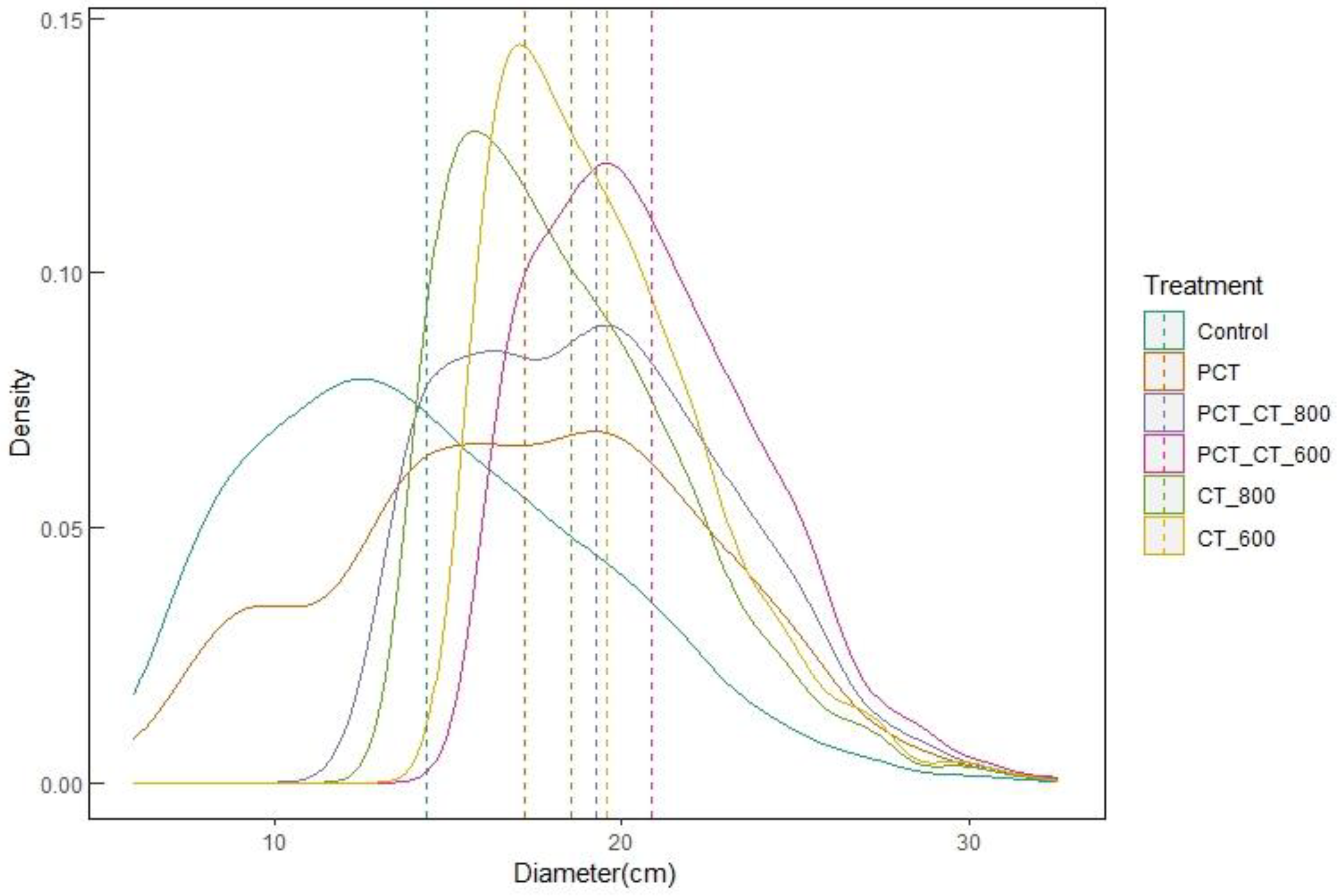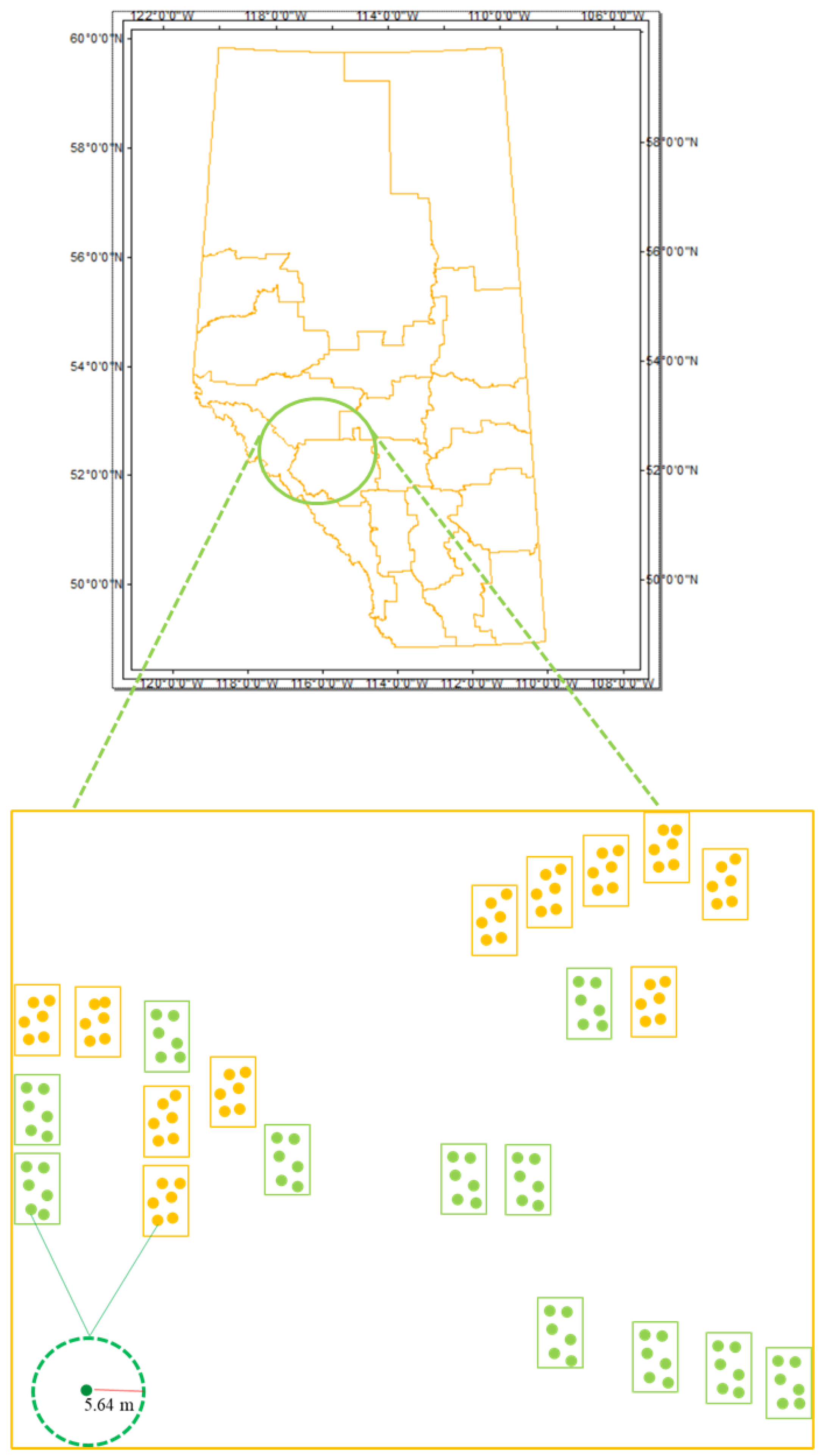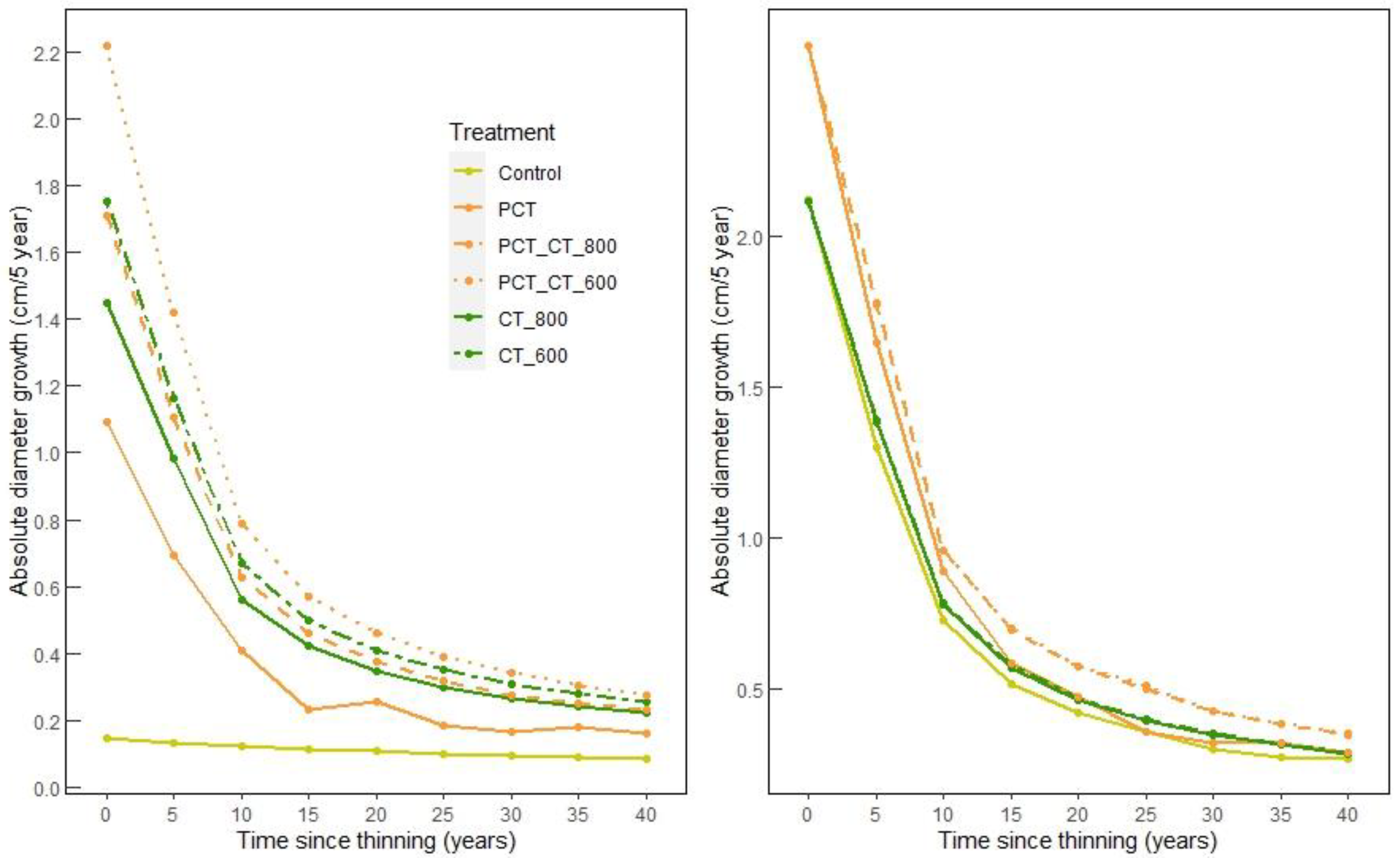Thinning Increases Individual Tree Growth While Reducing the Growth Heterogeneity of Lodgepole Pine
Abstract
1. Introduction
- How do contrasting thinning treatments and time since thinning affect the individual tree diameter growth and height diameter ratio of lodgepole pine?
- Does thinning equally benefit all the trees in the residual stands and how does the variability of tree growth change over time since thinning?
2. Materials and Methods
2.1. Study Area and Experimental Design
2.2. Data Collection and Analysis
3. Results
4. Discussion
5. Conclusions
Author Contributions
Funding
Data Availability Statement
Acknowledgments
Conflicts of Interest
Appendix A
| Time since Thinning | PCT | CT_800 | CT_600 | PCT_CT_800 | PCT_CT_600 |
|---|---|---|---|---|---|
| 0 | 7.45 | 9.86 | 11.95 | 11.65 | 15.13 |
| 5 | 5.25 | 7.43 | 8.81 | 8.39 | 10.77 |
| 10 | 3.31 | 4.57 | 5.43 | 5.10 | 6.41 |
| 15 | 2.01 | 3.68 | 4.33 | 4.02 | 4.98 |
| 20 | 2.36 | 3.23 | 3.78 | 3.48 | 4.27 |
| 25 | 1.818 | 2.96 | 3.45 | 3.16 | 3.84 |
| 30 | 1.75 | 2.77 | 3.22 | 2.87 | 3.54 |
| 35 | 1.95 | 2.64 | 3.06 | 2.77 | 3.33 |
| 40 | 1.89 | 1.55 | 1.95 | 1.65 | 2.17 |
Appendix B

References
- Weiskittel, A.R.; Hann, D.W.; Kershaw, J.A., Jr.; Vanclay, J.K. Forest Growth and Yield Modeling; John Wiley & Sons: Hoboken, NJ, USA, 2011. [Google Scholar]
- Zeide, B. Thinning and growth: A full turnaround. J. For. 2001, 99, 20–25. [Google Scholar]
- Curtis, R.O.; Marshall, D.D.; Bell, J.F. A pioneering example of silvicultural research in coast Douglas-fir. J. For. 1997, 95, 19–25. [Google Scholar]
- Wallentin, C. Thinning of Norway spruce. Ph.D. Dissertation, Swedish University of Agricultural Sciences, Uppsala, Sweden, 2016. [Google Scholar]
- O’hara, K.L. Stand growth efficiency in a Douglas fir thinning trial. For. Int. J. For. Res. 1989, 62, 409–418. [Google Scholar] [CrossRef]
- Lagergren, F.; Lankreijer, H.; Kučera, J.; Cienciala, E.; Mölder, M.; Lindroth, A. Thinning effects on pine-spruce forest transpiration in central Sweden. For. Ecol. Manag. 2008, 255, 2312–2323. [Google Scholar] [CrossRef]
- Kuehne, C.; Weiskittel, A.R.; Wagner, R.G.; Roth, B.E. Development and evaluation of individual tree-and stand-level approaches for predicting spruce-fir response to commercial thinning in Maine, USA. For. Ecol. Manag. 2016, 376, 84–95. [Google Scholar] [CrossRef]
- Sharma, M.; Smith, M.; Burkhart, H.E.; Amateis, R.L. Modeling the impact of thinning on height development of dominant and codominant loblolly pine trees. Ann. For. Sci. 2006, 63, 349–354. [Google Scholar] [CrossRef]
- Bose, A.K.; Harvey, B.D.; Brais, S.; Beaudet, M.; Leduc, A. Constraints to partial cutting in the boreal forest of Canada in the context of natural disturbance-based management: A review. Forestry 2014, 87, 11–28. [Google Scholar] [CrossRef]
- Giuggiola, A.; Ogée, J.; Rigling, A.; Gessler, A.; Bugmann, H.; Treydte, K. Improvement of water and light availability after thinning at a xeric site: Which matters more? A dual isotope approach. New Phytol. 2016, 210, 108–121. [Google Scholar] [CrossRef]
- Scott, R.E.; Mitchell, S.J. Empirical modelling of windthrow risk in partially harvested stands using tree, neighbourhood, and stand attributes. For. Ecol. Manag. 2005, 218, 193–209. [Google Scholar] [CrossRef]
- Canham, C.D.; Papaik, M.J.; Uriarte, M.; McWilliams, W.H.; Jenkins, J.C.; Twery, M.J. Neighborhood analyses of canopy tree competition along environmental gradients in New England forests. Ecol. Appl. 2006, 16, 540–554. [Google Scholar] [CrossRef]
- Thorpe, H.C.; Thomas, S.C.; Caspersen, J.P. Residual-tree growth responses to partial stand harvest in the black spruce (Picea mariana) boreal forest. Can. J. For. Res. 2007, 37, 1563–1571. [Google Scholar] [CrossRef]
- Anning, A.K.; McCarthy, B.C. Competition, size and age affect tree growth response to fuel reduction treatments in mixed-oak forests of Ohio. For. Ecol. Manag. 2013, 307, 74–83. [Google Scholar] [CrossRef]
- Jones, T.A.; Domke, G.M.; Thomas, S.C. Canopy tree growth responses following selection harvest in seven species varying in shade tolerance. Can. J. For. Res. 2009, 39, 430–440. [Google Scholar] [CrossRef]
- Valinger, E.; Elfving, B.; Mörling, T. Twelve-year growth response of Scots pine to thinning and nitrogen fertilisation. For. Ecol. Manag. 2000, 134, 45–53. [Google Scholar] [CrossRef]
- Holgén, P.; Söderberg, U.; Hånell, B. Diameter increment in Picea abies shelterwood stands in northern Sweden. Scand. J. For. Res. 2003, 18, 163–167. [Google Scholar] [CrossRef]
- Krebs, V.S. White spruce advanced regeneration response to Strip Cut Understory Protection harvesting. Master’s Thesis, University of Alberta, Edmonton, AB, Canada, 2016. [Google Scholar]
- Bose, A.K.; Weiskittel, A.; Kuehne, C.; Wagner, R.G.; Turnblom, E.; Burkhart, H.E. Tree-level growth and survival following commercial thinning of four major softwood species in North America. For. Ecol. Manag. 2018, 427, 355–364. [Google Scholar] [CrossRef]
- Weetman, G. Intensive forest management: Its relationship to AAC and ACE. For. Chron 2002, 78, 255–259. [Google Scholar] [CrossRef]
- Griess, V.C.; Man, C.D.; Polinko, A.D.; Spies, J. Mitigating midterm timber supply shortage using commercial thinning operations. A case study from British Columbia, Canada. For. Ecol. Manag. 2019, 443, 1–8. [Google Scholar] [CrossRef]
- Pinno, B.D.; Hossain, K.L.; Gooding, T.; Lieffers, V.J. Opportunities and challenges for intensive silviculture in Alberta, Canada. Forests 2021, 12, 791. [Google Scholar] [CrossRef]
- Bell, F.W.; Pitt, D.G.; Wester, M.C. Is Intensive Forest Management a misnomer? An Ontario-based discussion of terminology and an alternative approac. For. Chron 2006, 82, 662–674. [Google Scholar] [CrossRef]
- Gupta, S.D.; Pinno, B.D.; McCready, T. Commercial thinning effects on growth, yield and mortality in natural lodgepole pine stands in Alberta. For. Chron 2020, 96, 111–120. [Google Scholar] [CrossRef]
- Dempster, W.R. Effects of Planting, Vegetation Management, and Pre-Commercial Thinning on the Growth and Yield of Lodgepole Pine Regenerated after Harvesting in Alberta, Canada. Forests 2022, 13, 929. [Google Scholar] [CrossRef]
- Hossain, K.L.; Lieffers, V.J.; Pinno, B.D. Thinning to meet sawlog objectives at shorter rotation in lodgepole pine stands. Can. J. For. Res. 2022, 52, 940–950. [Google Scholar] [CrossRef]
- Mäkinen, H.; Isomäki, A. Thinning intensity and growth of Scots pine stands in Finland. For. Ecol. Manag. 2004, 201, 311–325. [Google Scholar] [CrossRef]
- Mehtätalo, L.; Peltola, H.; Kilpeläinen, A.; Ikonen, V.P. The response of basal area growth of Scots pine to thinning: A longitudinal analysis of tree-specific series using a nonlinear mixed-effects model. For. Sci. 2014, 60, 636–644. [Google Scholar] [CrossRef]
- Houtmeyers, S.; Brunner, A. Thinning responses of individual trees in mixed stands of Norway spruce and Scots pine. Scand. J. For. Res. 2020, 35, 351–366. [Google Scholar] [CrossRef]
- Ara, M.; Berglund, M.; Fahlvik, N.; Johansson, U.; Nilsson, U. Pre-Commercial Thinning Increases the Profitability of Norway Spruce Monoculture and Supports Norway Spruce–Birch Mixture over Full Rotations. Forests 2022, 13, 1156. [Google Scholar] [CrossRef]
- Huang, S.; Yang, Y.; Aitkin, D. Population and Plot-Specific Tree Diameter and Height Prediction Models for Major Alberta Tree Species; Alberta Agriculture and Forestry: Edmonton, AB, Canada, 2016; 76p.
- Alberta Environment and Sustainable Resource Development. In Performance Age Silviculture Scenario Tool-User’s Manual. Application Version 2013.05.07k; Department of Environmental and Sustainable Resource Development, Government of Albert: Edmonton, AB, Canada, 2014; p. 35.
- MGM Development Team. Mixedwood Growth Model. Available online: https://mgm.ualberta.ca (accessed on 23 May 2023).
- Bokalo, M.; Stadt, K.J.; Comeau, P.G.; Titus, S.J. The validation of the Mixedwood Growth Model (MGM) for use in forest management decision making. Forests 2013, 4, 1–27. [Google Scholar] [CrossRef]
- Zeileis, A.; Kleiber, C.; Zeileis, M.A. Package ‘ineq’. Tech. Rep. Available online: https://cran.r-project.org/web/packages/ineq/ineq.pdf (accessed on 23 May 2023).
- R Development Core Team. R: A Language and Environment for Statistical Computing; R Foundation for Statistical Computing: Vienna, Austria, 2015. [Google Scholar]
- Liziniewicz, M.; Ekö, P.M.; Agestam, E. Effect of spacing on 23-year-old lodgepole pine (Pinus contorta Dougl. var. latifolia) in southern Sweden. Scand. J. For. Res. 2012, 27, 361–371. [Google Scholar] [CrossRef]
- Pfister, O.; Wallentin, C.; Nilsson, U.; Ekö, P.M. Effects of wide spacing and thinning strategies on wood quality in Norway spruce (Picea abies) stands in southern Sweden. Scand. J. For. Res. 2007, 22, 333–343. [Google Scholar] [CrossRef]
- Pettersson, N. The effect of density after precommercial thinning on volume and structure in Pinus sylvestris and Picea abies stands. Scand. J. For. Res. 1993, 8, 528–539. [Google Scholar] [CrossRef]
- Uotila, K.; Saksa, T. Effects of early cleaning on young Picea abies stands. Scand. J. For. Res. 2014, 29, 111–119. [Google Scholar] [CrossRef]
- Ara, M.; Felton, A.M.; Holmström, E.; Petersson, L.; Berglund, M.; Johansson, U.; Nilsson, U. Pre-commercial thinning in Norway spruce-birch mixed stands can provide abundant forage for ungulates without losing volume production. For. Ecol. Manag. 2022, 520, 120364. [Google Scholar] [CrossRef]
- Brissette, J.C.; Frank, R.M., Jr.; Stone, T.L.; Skratt, T.A. Precommercial thinning in a northern conifer stand: 18-year results. For. Chron 1999, 75, 967–972. [Google Scholar] [CrossRef]
- Pothier, D. Twenty-year results of precommercial thinning in a balsam fir stand. For. Ecol. Manag. 2002, 168, 177–186. [Google Scholar] [CrossRef]
- Simard, S.W.; Blenner-Hassett, T.; Cameron, I.R. Pre-commercial thinning effects on growth, yield and mortality in even-aged paper birch stands in British Columbia. For. Ecol. Manag. 2004, 190, 163–178. [Google Scholar] [CrossRef]
- Chase, C.W.; Kimsey, M.J.; Shaw, T.M.; Coleman, M.D. The response of light, water, and nutrient availability to pre-commercial thinning in dry inland Douglas-fir forests. For. Ecol. Manag. 2016, 363, 98–109. [Google Scholar] [CrossRef]
- Montero, G.; Cañellas, I.; Ortega, C.; Del Rio, M. Results from a thinning experiment in a Scots pine (Pinus sylvestris L.) natural regeneration stand in the Sistema Ibérico Mountain Range (Spain). For. Ecol. Manag. 2001, 145, 151–161. [Google Scholar] [CrossRef]
- Del Río, M.; Calama, R.; Cañellas, I.; Roig, S.; Montero, G. Thinning intensity and growth response in SW-European Scots pine stands. Ann. For. Sci. 2008, 65, 1. [Google Scholar] [CrossRef]
- Wagle, B.H.; Weiskittel, A.R.; Kizha, A.R.; Berrill, J.P.; D’Amato, A.W.; Marshall, D. Long-term influence of commercial thinning on stand structure and yield with/without pre-commercial thinning of spruce-fir in northern Maine, USA. For. Ecol. Manag. 2022, 522, 120453. [Google Scholar] [CrossRef]
- Daniels, R.F.; Burkhart, H.E.; Clason, T.R. A comparison of competition measures for predicting growth of loblolly pine trees. Can. J. For. Res. 1986, 16, 1230–1237. [Google Scholar] [CrossRef]
- Drake, J.E.; Raetz, L.M.; Davis, S.C.; Delucia, E.H. Hydraulic limitation not declining nitrogen availability causes the age-related photosynthetic decline in loblolly pine (Pinus taeda L.). Plant Cell Environ. 2010, 33, 1756–1766. [Google Scholar] [CrossRef] [PubMed]
- Kuehne, C.; Weiskittel, A.; Pommerening, A.; Wagner, R.G. Evaluation of 10-year temporal and spatial variability in structure and growth across contrasting commercial thinning treatments in spruce-fir forests of northern Maine, USA. Ann. For. Sci. 2018, 75, 20. [Google Scholar] [CrossRef]
- Zhao, D.; Bullock, B.P.; Montes, C.R.; Wang, M. Production, tree size inequality and growth dominance in loblolly pine plantations under different silvicultural management regimes. For. Ecol. Manag. 2022, 526, 120594. [Google Scholar] [CrossRef]
- Bradford, J.B.; D’Amato, A.W.; Palik, B.J.; Fraver, S. A new method for evaluating forest thinning: Growth dominance in managed Pinus resinosa stands. Can. J. For. Res. 2010, 40, 843–849. [Google Scholar] [CrossRef]
- Soares, A.A.; Leite, H.G.; Cruz, J.P.; Forrester, D.I. Development of stand structural heterogeneity and growth dominance in thinned Eucalyptus stands in Brazil. For. Ecol. Manag. 2017, 384, 339–346. [Google Scholar] [CrossRef]
- Fernández, M.E.; Gyenge, J. Testing Binkley’s hypothesis about the interaction of individual tree water use efficiency and growth efficiency with dominance patterns in open and close canopy stands. For. Ecol. Manag. 2009, 257, 1859–1865. [Google Scholar] [CrossRef]
- Forrester, D.I.; Collopy, J.J.; Beadle, C.L.; Warren, C.R.; Baker, T.G. Effect of thinning, pruning and nitrogen fertiliser application on transpiration, photosynthesis and water-use efficiency in a young Eucalyptus nitens plantation. For. Ecol. Manag. 2012, 266, 286–300. [Google Scholar] [CrossRef]
- Varmola, M.; Salminen, H. Timing and intensity of precommercial thinning in Pinus sylvestris stands. Scand. J. For. Res. 2004, 19, 142–151. [Google Scholar] [CrossRef]
- Wallentin, C.; Nilsson, U. Storm and snow damage in a Norway spruce thinning experiment in southern Sweden. Forestry 2014, 87, 229–238. [Google Scholar] [CrossRef]
- Valinger, E.; Pettersson, N. Wind and snow damage in a thinning and fertilization experiment in Picea abies in southern Sweden. For. Int. J. For. Res. 1996, 69, 25–33. [Google Scholar] [CrossRef]



| Initial Treatments | Simulated Treatments | Average Number of Trees ha−1 | |
|---|---|---|---|
| Before Thinning | After Thinning | ||
| Control | Control | 2079 | 2079 |
| CT_800 | 2079 | 800 | |
| CT_600 | 2079 | 600 | |
| PCT | PCT | 1377 | 1377 |
| PCT_CT_800 | 1377 | 800 | |
| PCT_CT_600 | 1377 | 600 | |
| Treatment | Mean Diameter and Range of Diameter (cm) | |||
|---|---|---|---|---|
| Age 58 | Age 60 | Age 65 | ||
| Before Thinning | After Thinning | |||
| Control | 13.30 Range: 5.1–30 | 13.74 Range: 5.5–30.58 | 13.74 (no thinning) Range: 5.5–30.58 | 14.40 Range: 5.97–31.47 |
| CT_800 | 13.30 Range: 5.1–30 | 13.74 Range: 5.5–30.58 | 17.64 Range: 13.37- 30.58 | 18.56 Range: 14.11–31.47 |
| CT_600 | 13.30 Range: 5.1–30 | 13.74 Range: 5.5–30.58 | 18.56 Range:14.73–30.58 | 19.56 Range: 15.53–31.47 |
| PCT | 16.04 Range: 5–30.4 | 16.51 Range: 5.38–31.26 | 16.51 (no thinning) Range:5.38–31.26 | 17.27 Range: 5.97–32.58 |
| PCT_CT_800 | 16.04 Range: 5–30.4 | 16.51 Range: 5.38–31.26 | 18.43 Range: 12.20–31.26 | 19.28 Range: 12.97–32.57 |
| PCT_CT_600 | 16.04 Range: 5–30.4 | 16.51 Range: 5.38–31.26 | 19.96 Range: 15.36–31.26 | 20.85 Range:16.09–32.57 |
Disclaimer/Publisher’s Note: The statements, opinions and data contained in all publications are solely those of the individual author(s) and contributor(s) and not of MDPI and/or the editor(s). MDPI and/or the editor(s) disclaim responsibility for any injury to people or property resulting from any ideas, methods, instructions or products referred to in the content. |
© 2023 by the authors. Licensee MDPI, Basel, Switzerland. This article is an open access article distributed under the terms and conditions of the Creative Commons Attribution (CC BY) license (https://creativecommons.org/licenses/by/4.0/).
Share and Cite
Ara, M.; Pinno, B.D.; Scaria, F.; Froese, R.E.; Bokalo, M. Thinning Increases Individual Tree Growth While Reducing the Growth Heterogeneity of Lodgepole Pine. Forests 2023, 14, 1091. https://doi.org/10.3390/f14061091
Ara M, Pinno BD, Scaria F, Froese RE, Bokalo M. Thinning Increases Individual Tree Growth While Reducing the Growth Heterogeneity of Lodgepole Pine. Forests. 2023; 14(6):1091. https://doi.org/10.3390/f14061091
Chicago/Turabian StyleAra, Mostarin, Bradley D. Pinno, Francis Scaria, Robert E. Froese, and Mike Bokalo. 2023. "Thinning Increases Individual Tree Growth While Reducing the Growth Heterogeneity of Lodgepole Pine" Forests 14, no. 6: 1091. https://doi.org/10.3390/f14061091
APA StyleAra, M., Pinno, B. D., Scaria, F., Froese, R. E., & Bokalo, M. (2023). Thinning Increases Individual Tree Growth While Reducing the Growth Heterogeneity of Lodgepole Pine. Forests, 14(6), 1091. https://doi.org/10.3390/f14061091






